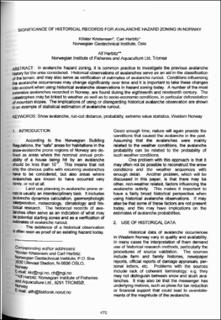| dc.contributor.author | Kristensen, Krister | |
| dc.contributor.author | Harbitz, Carl Bonnevie | |
| dc.contributor.author | Harbitz, Alf | |
| dc.coverage.spatial | Western Norway | en_US |
| dc.date.accessioned | 2023-08-14T10:46:02Z | |
| dc.date.available | 2023-08-14T10:46:02Z | |
| dc.date.issued | 2000 | |
| dc.identifier.uri | https://hdl.handle.net/11250/3083773 | |
| dc.description.abstract | In avalanche hazard zoning, it is common practice to investigate the previous avalanche history for the area considered. Historical observations of avalanches serve as an aid in the classification of the terrain, and may also serve as verification of estimates of avalanche runout. Conditions influencing the avalanche occurrences may change significantly over time and it is important to take these changes into account when using historical avalanche observations in hazard ioning today. A number of the most extensive avalanches recorded in Norway, are found during the eigthteenth and nineteenth century. The catastrophes may be linked to weather as well as to socio-econornic conditions, in particular deforestation of mountain slopes. The implications of using or disregarding historical avalanche observation are shown in an example of statistical estimation of avalanche runout. | en_US |
| dc.language.iso | eng | en_US |
| dc.publisher | Montana State University Library | en_US |
| dc.relation.ispartofseries | The International Snow Science Workshop (ISSW) Proceedings; | |
| dc.subject | Snøskred-FoU | en_US |
| dc.subject | Avalanche-RnD | en_US |
| dc.subject | Statistical Analysis | en_US |
| dc.subject | Runout Distance | en_US |
| dc.subject | Probability | en_US |
| dc.subject | Hazard | en_US |
| dc.subject | Snow Avalanche | en_US |
| dc.subject | Western Norway | en_US |
| dc.subject | Extreme Value Statistics | en_US |
| dc.title | Significance of historical records for avalanche hazard zoning in Norway | en_US |
| dc.type | Chapter | en_US |
| dc.source.pagenumber | 475-480 (6s) | en_US |
